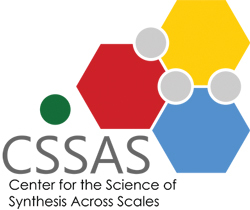By Lindsey Doermann
October 17, 2022
 The Center for the Science of Synthesis Across Scales (CSSAS), a multi-institutional research initiative led by professor François Baneyx and Dr. Jim De Yoreo of PNNL, has received a 4-year $12.6M renewal from the U.S. Department of Energy. Using nature as inspiration, CSSAS researchers are elucidating design rules for macromolecular building blocks that predictively self-assemble into advanced materials.
The Center for the Science of Synthesis Across Scales (CSSAS), a multi-institutional research initiative led by professor François Baneyx and Dr. Jim De Yoreo of PNNL, has received a 4-year $12.6M renewal from the U.S. Department of Energy. Using nature as inspiration, CSSAS researchers are elucidating design rules for macromolecular building blocks that predictively self-assemble into advanced materials.
Established in 2018, CSSAS is one of the DOE’s 43 Energy Frontier Research Centers, set up to address scientific challenges preventing advances in energy technologies. The funding comes as part of a larger $540M package to transform energy production and cut emissions. Toward this effort, CSSAS is contributing foundational science that will be critical in orchestrating the precise organization of components for next generation photovoltaics, batteries, photocatalysts, and more.
In the center’s first 4 years, researchers have gained a deeper understanding of the rules by which protein, peptide, polymer, and nanoparticle blocks come together into hierarchical materials. For example, they are uncovering the profound effects that solvents, ions, and surfaces have on materials assembly and reconfiguration.

Moving forward with CSSAS 2.0, Baneyx says, the highly interdisciplinary group of researchers will have the space to think more deeply about what they have learned and how to generalize and deploy those lessons. “We’ll continue with many of the projects we’ve been pursuing, pushing the boundary of what is possible in predictive materials assembly,” he says. “We won’t just create complex structures for the sake of creating complex structures, but we’ll do so with an understanding of how to achieve user-specified architectures and with an eye towards practical applications.”
Future work will broaden the research scope, expand design principles, and apply new methods and tools. In one research thrust, they will use DNA origami to build organizational scaffolds. In another line of inquiry, they will take their understanding of the molecular interactions between disparate blocks, surfaces, solvents, and electrolytes, and apply it to realize 2D and 3D hierarchical and hybrid materials that can be switched between different or previously inaccessible states. In addition, they will experiment with AI-driven synthesis to accelerate materials discovery.
The University of Washington and Pacific Northwest National Laboratory serve as the primary institutions for CSSAS, with involvement from UC San Diego, University of Chicago, Columbia University, and University of Tennessee. For more information, visit www.cssas-efrc.com.